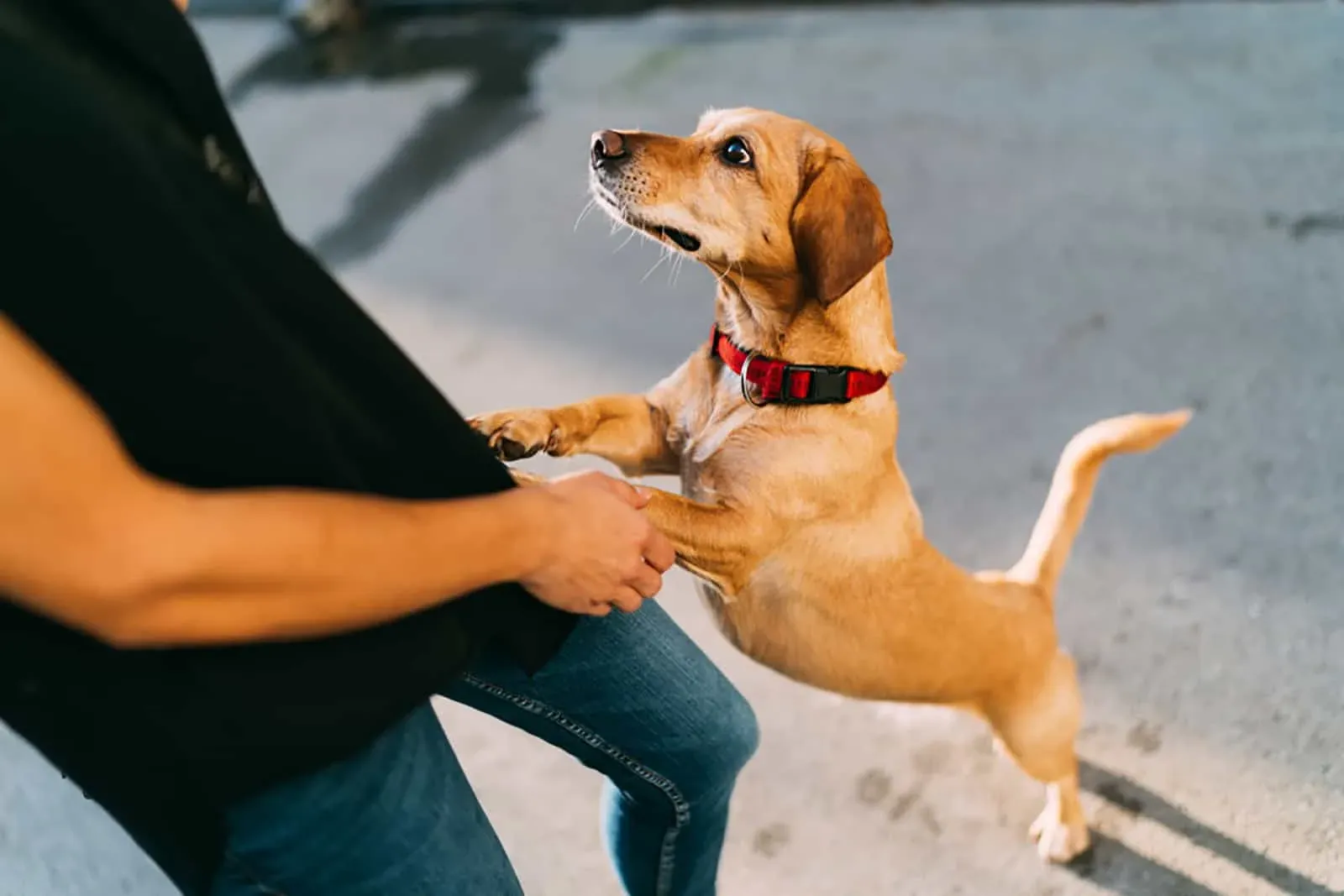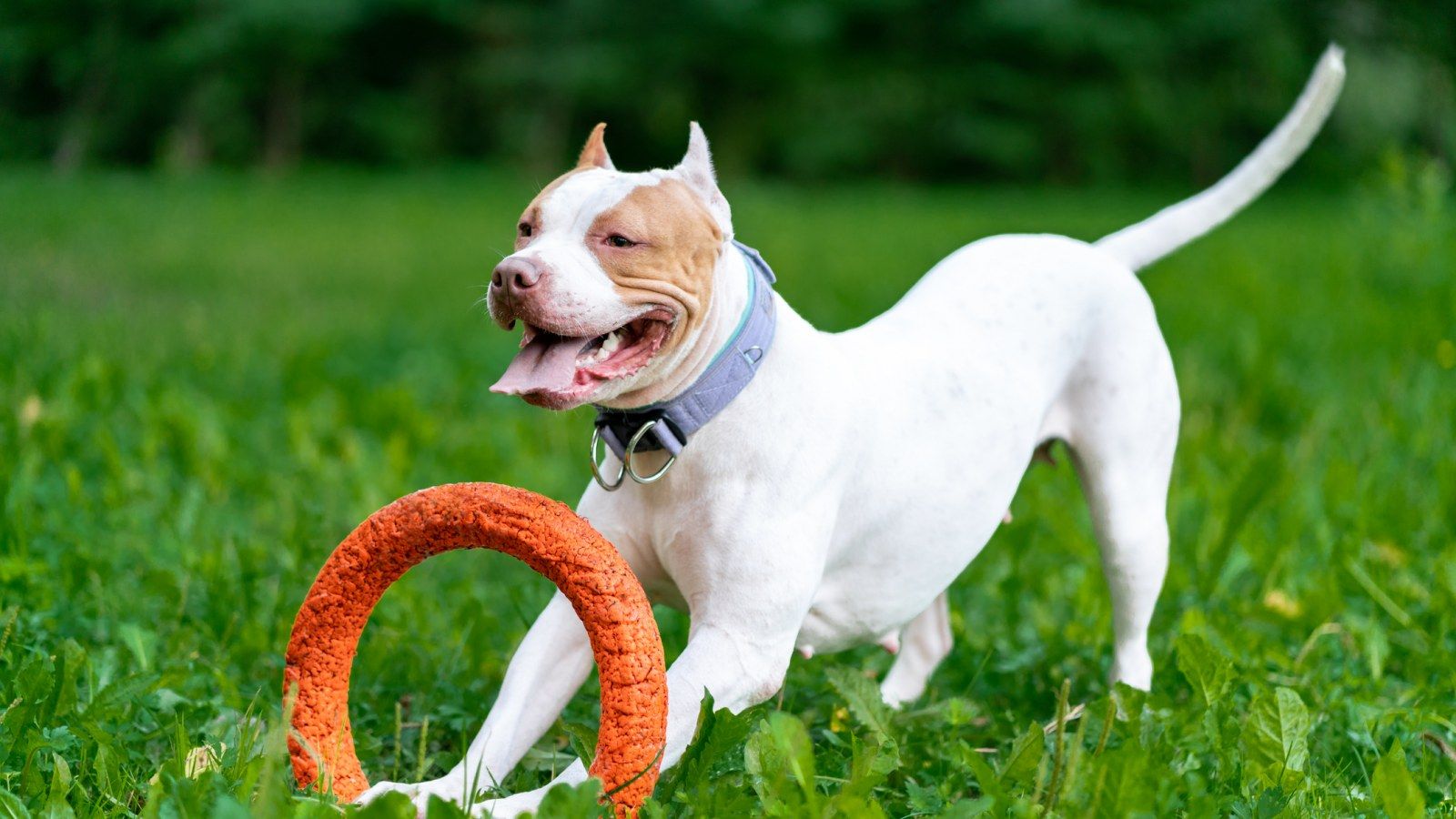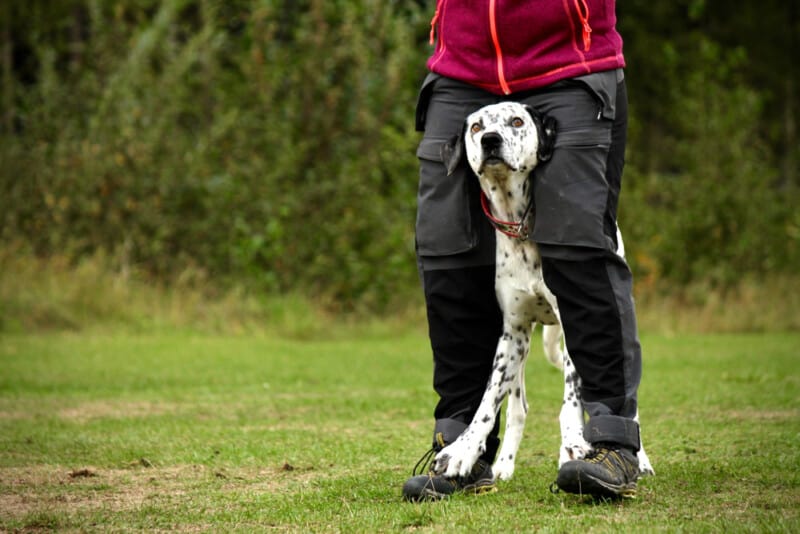Why do our furry friends stand over us? It's a display of dominance or protection. Dogs are instinctively pack animals, so by being higher up, they assert their authority.

But, there could be more to it. One reason is they may need attention or reassurance. Dogs are social and desire interaction with us. It could also be because they're instinctively protecting and guarding us. They may stand over us to keep an eye out for any threats. This shows their loyalty to us.
Understand Your Dog's Behavior with the Fi Dog Collar
Understanding your dog's behavior, including why they stand over you, is essential for building a healthy relationship. Whether they're seeking dominance, protection, or simply attention, gaining insights into their actions can help you better communicate with them. The Fi Dog Collar provides a smart way to understand your pet's behavior patterns, allowing you to track their activity levels and location directly from your phone. Equip your furry friend with the Fi Dog Collar today to ensure their safety while deepening your understanding of their unique behaviors.
Understanding the Behavior of Your Dog Standing Over You
Uncover the reasons behind this peculiar canine behavior and gain valuable insight into your furry friend's actions.
Seeking Attention or Affection
We all crave attention and affection. It's a deep, human need that influences how we act and feel. There are several ways to seek this:
- Expressing Emotions: We may try to get people to understand us better by showing vulnerability.
- Performing Extraordinary Feats: Some people aim to gain admiration and validation by displaying their skills or doing impressive things.
- Displaying Positive Behavior: Doing nice things can draw attention and affection from others.
- Seeking Approval: Many people look for acceptance from parents, peers, or superiors.
It's important to remember that seeking attention or affection doesn't mean manipulating people. Genuine interactions are key for emotional development.

To satisfy this need, here are some tips:
- Develop Self-Compassion: Acknowledge your own worth. This will help you find fulfillment within yourself.
- Practice Active Listening: Show genuine interest in others and try to understand their feelings.
- Nurture Existing Relationships: Spend time with family, friends, and partners. Show appreciation through small acts of kindness.
- Join Social Groups: Participate in activities or groups that match your passions. Meet new people and form connections.
By doing these things, you can create a strong base of genuine attention and affection in your life, leading to more satisfaction and well-being.
Guarding Behavior
Animals display guarding behavior to protect their territory, young, and resources. This instinctive response is a fascinating trait that showcases their innate protection. For instance, animals may exhibit aggressive displays and vocalizations to deter intruders. Additionally, guarding behavior may vary among different species, based on genetics, environment, and social dynamics.
Moreover, the intensity and period of guarding can depend on the perceived risk or value of the resource being defended. Investigating guarding behavior can provide insight into the evolution of various animal species' survival strategies. Fascinatingly, some bird species like the European Roller have cooperative guarding behavior, where multiple birds work together to protect their nests from predators, thus increasing the success rate of protecting their offspring.
Possible Reasons for the Behavior
To better understand why your dog stands over you, let's explore the possible reasons for this behavior. Discovering whether it's dominance or territory marking, protection or anxiety, or simply a learned behavior will provide solutions to address this curious habit.
Dominance or Territory Marking
Animals show dominance or mark their territories in various ways. For example, lions roar and scent mark to show dominance. Wolves howl to define their territory and warn others away. Elephants trumpet and rub on trees to communicate. Birds sing loudly and display their wings.
These behaviors are distinct to the species. Lions use roaring and scent marking. Wolves howl and act aggressively. Elephants trumpet and rub trees. And birds sing and display their wings.
These actions offer insight into animal communication and social structures. By understanding the motivations behind them, we can gain appreciation for the world of animal behavior.
If this interests you, explore animal behavior further. It is an ever-changing field with new discoveries about animal interaction and their environment. Don't miss this chance to learn about nature!
Protection or Anxiety
Protection or Anxiety has many elements to consider. Fearful reactions, hypervigilance, past traumatic events, and defense mechanisms are key factors.
Going deeper, we find this behavior is rooted in an individual's past, personality traits, or environment. The National Institute of Mental Health found that anxiety disorders link to excessive protection. This knowledge helps us understand Protection or Anxiety better.
It is a complex response to various catalysts. If we can identify triggers and comprehend the causes, we can be more empathetic towards people experiencing this behavior.
Learned Behavior
Humans have an amazing capability to learn from their experiences and adjust their actions accordingly. This is known as learned behavior. It lets people gain new skills, understanding and outlooks through watching, copying and practicing. Learning never stops; it goes on throughout a person's life, changing their ideas, decisions and connections with the world.
Learned behavior can be impacted by a range of elements, such as social customs, social links and personal events. Social customs are very influential in shaping a person's behavior, as they give directions on what is allowed or suitable in a particular society. People often imitate the behavior of the people around them to fit in or be accepted by their group.
Personal encounters also help shape learned behavior. Positive experiences support certain behaviors by connecting them to enjoyable results, whereas negative experiences discourage them by linking them to discomfort or penalty. Through trial and error, individuals figure out which activities lead to good results and adapt their behavior accordingly.

In addition to social customs and personal encounters, individual distinctions also have an effect on learned behavior. Everyone has unique intellectual abilities, character qualities and learning techniques that affect how they interpret and process information. Some people may learn better through visual stimuli, while others may prefer auditory or practical learning methods.
Learned behavior can be forgotten or modified over time. This adaptability allows people to modify to changing situations or take on new behaviors when necessary. By appreciating this section of learned behavior, one can deliberately engage in self-reflection and intentionally question well-established patterns of thinking or acting that may not be helpful anymore.
Pro Tip: Keep on learning by taking on new experiences and looking for chances for growth. Bear in mind that the aptitude for learning is limitless; it is never too late to gain new skills or alter your view on life.
Tips for Handling the Behavior
To handle the behavior of your dog standing over you, use effective strategies for establishing dominance and leadership, providing proper training and mental stimulation, and ensuring a safe and comfortable environment. By implementing these solutions, you can address this behavior and cultivate a healthier dynamic with your furry friend.
Establishing Dominance and Leadership
Dominance and leadership are key to successful behaviour management. Show your authority by asserting dominance. Here are some tips:
- Lead by example - demonstrate the behaviour you want others to follow.
- Communicate clearly - make sure expectations are understood.
- Be consistent - have predictable rules and consequences.
- Acknowledge achievements - reward good behaviour.
Plus, set boundaries and address disruptive behaviour quickly. Being consistent with these strategies will create harmony.
Fun fact: Harvard Business Review reports that leaders who establish dominance through positive methods are more likely to have satisfied employees.
Providing Proper Training and Mental Stimulation
Training and mental stimulation are key for proper behavior. By giving the correct guidance and mental challenges, you can ensure a well-behaved and content individual or pet.
- To begin, set up a consistent training routine.
- Award desired behavior with positive reinforcement techniques.
- Interactive activities stimulate the mind.
- Furnish an enriching environment with puzzle toys and games.
- Instruct new commands and tricks to keep the mind sharp.
- Be patient and consistent for lasting behavioral improvements.
Bear in mind that everyone is unique, so tailor the training to their needs. Monitor their reactions and make adjustments accordingly.
Take a dog as an example. It displayed destructive behavior due to boredom. With committed training and agility courses for fun, the dog's behavior changed dramatically. This success story demonstrates the potency of physical and mental enrichment for animals.
Ensuring a Safe and Comfortable Environment
Essential for a favourable atmosphere in any setting, safety and comfort must be guaranteed. Be it a workplace, educational institution or community space, this ensures productivity, learning and wellbeing.

- 1. Physical safety must be ensured by implementing measures like emergency exits, first-aid kits and regular equipment maintenance. This prevents accidents and reduces risks.
- 2. Making the environment comfortable includes factors like lighting, temperature control and ergonomic furniture. These elements contribute to the well-being of individuals, reducing strain and increasing comfort.
- Lastly, safe psychological environment is essential. Open communication channels, speedy resolution of issues and inclusivity let everyone feel valued and respected.
Safety drills and training on emergency procedures should be conducted for preparedness. This way people feel secure.
Pro Tip: Get feedback from people about their experience. This shows that their opinions are valued and helps improve safety and comfort levels.
Seeking Professional Help
To address the seeking professional help for "why does my dog stand over me," turn to trusted experts like a dog behaviorist or trainer. When the behavior becomes aggressive or unmanageable, seeking their guidance can provide effective solutions for your dog's behavior.
When the Behavior Becomes Aggressive or Uncontrollable
When behavior becomes wild and out of control, it is essential to find professional help. Here are five things to mull over:
- Know the signs. This might be physical violence, verbal abuse or damaging of possessions.
- Figure out what triggers it. Knowing this can help you manage it better and stop it from happening again.
- Look into therapy options. This will provide methods for dealing with anger, improving communication abilities and treating the root cause.
- Think about medicine. In some cases, a doctor may prescribe drugs to assist in controlling aggression and regulating mood.
- Plan a safety strategy. A professional can help you make a plan for keeping both the individual and those around them safe.
It's a good idea to get professional help too, as they have training in handling aggressive behavior and can give valuable advice. Doing something in advance to get support will help with personal development and general well-being.
Harvard Medical School has uncovered an intriguing truth: therapy can reduce aggression drastically if it is used early.

Consulting a Dog Behaviorist or Trainer
Seeking help from a professional dog behaviorist or trainer can be hugely beneficial for you and your pup. They have deep knowledge and experience in decoding canine behavior, and can provide priceless instruction to address any behavioral issues your pup may have.
- The experts can help you work out the source of your pup's behaviors, like aggression, distress, or excessive barking.
- They'll create a personal training plan that fits your pup's needs and character.
- With positive reinforcement methods, they'll teach your pup good behavior, like walking on a leash or obeying commands.
- They'll also give you the essential tools and approaches to communicate with your pet, leading to a closer bond and better obedience.
- If necessary, they can assist in socializing your pup with other animals or people, reducing any potential worry or aggression.
- A professional can offer long-term support and direction throughout the training period, ensuring successful results for you and your pet.
Apart from these perks, consulting a dog behaviorist or trainer allows you to get insight into canine psychology that you may not have had before. By getting to the bottom of certain behaviors, you can develop empathy towards your furry pal and take an understanding approach to training.
Here's a real-life example of how consulting a pro made a profound difference in resolving behavioral problems. A family was having trouble with their aggressive rescue pup who was showing serious reactive behavior to other dogs. After getting help from a renowned dog behaviorist, they were able to work out the fearful triggers causing the aggression. With the expert's consistent training methods and positive reinforcement techniques, their beloved pup became a well-behaved and socialized pup.
Keep in mind, seeking expert help is not just an investment in your pet's wellness, but also in fostering a harmonious relationship between you and your pup. So don't hesitate to consult a dog behaviorist or trainer if you're dealing with any behavioral predicaments with your furry friend.
Conclusion
Why do our furry companions stand over us? Let's look into some reasons.
- Dominance: Dogs may stand to show they're the leader!
- Protection: They may be signalling they're ready to defend if needed.
- Attention: They could just be seeking love and affection.
- Guarding: This natural urge could be why they stand.
- Anxiety or Fear: Dogs may stand for comfort if they feel scared.
- Territorial Behavior: They could be protecting what they think is theirs.
Remember, each pup is unique! Knowing these reasons can help us understand their behavior.
To illustrate, my friend's Labrador Retriever stood over her while she was on the couch. She was puzzled at first, but soon realized it was his way of showing affection. Despite being large, he just wanted to be close and get ear scratches.
Frequently Asked Questions
- Why does my dog stand over me?
- Your dog may be standing over you as a sign of dominance. It's important to establish yourself as the pack leader and set boundaries to prevent any behavioral issues.
- Is my dog trying to assert dominance by standing over me?
- Yes, when a dog stands over you, it can be a show of dominance. However, it's essential to evaluate other factors, such as body language and context, to fully understand your dog's behavior.
- How can I discourage my dog from standing over me?
- To discourage your dog from standing over you, practice consistent obedience training and reinforce commands like "sit" or "lie down." Encouraging your dog to respect personal space will help establish the appropriate hierarchy.
- What if my dog standing over me is due to insecurity?
- Insecurity can also cause a dog to stand over you. It's crucial to provide a safe and secure environment for your dog, build trust through positive reinforcement, and consider professional help if the behavior persists.
- Are there any medical reasons for my dog to stand over me?
- While dominance or insecurity are common reasons, certain medical conditions like pain or discomfort can also make a dog stand over you. If you suspect a medical issue, it's best to consult a veterinarian for a proper diagnosis.
- Should I allow my dog to stand over me?
- Allowing your dog to stand over you can reinforce their dominant behavior. It's advisable to redirect this behavior by encouraging appropriate positions, such as sitting or lying down beside you, to maintain a healthy human-dog relationship.






